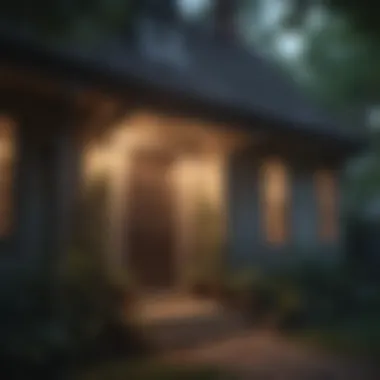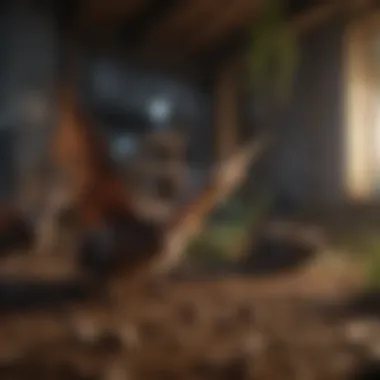Understanding Bat Entry into Homes: A Comprehensive Overview


Intro
Bats are often misunderstood creatures. While they are vital for ecosystems, their uninvited presence in homes can cause distress for many homeowners. Understanding how bat entry occurs is crucial for effective prevention. This article aims to dissect the entry methods of bats into residential areas, highlighting their ecological benefits alongside practical tips for keeping them at bay.
How Bats Enter Homes
Bats typically find their way into homes through several common entry points. Recognizing these areas can greatly assist in prevention. Here are some key entry routes bats may exploit:
- Gaps in Eaves and Roofs: Bats can slip through small openings in the roof eaves or under shingles.
- Attic Vents: Improperly screened vents can attract bats seeking shelter.
- Chimneys: Unused or uncapped chimneys provide a perfect entry point.
- Window Cracks: Open or damaged windows make it easy for bats to enter homes.
Being aware of these access points is the first step in safeguarding your home.
Importance of Bats in the Ecosystem
Bats fulfill important roles in nature. They primarily help with insect control. By consuming thousands of insects each night, they reduce the need for chemical pest control in gardens and fields. According to Wikipedia, bats are also vital for pollination and seed dispersion.
When bats are present, they contribute to maintaining a healthy ecosystem. However, their presence indoors needs to be managed to prevent potential health risks associated with bat droppings, which can harbor disease.
Effective Prevention Strategies
To protect your home from unwanted bat entry, consider these strategies:
- Seal Entry Points: Inspect your home thoroughly for any gaps or holes. Seal these with appropriate materials.
- Install Bat Screens: These screens can be applied to vents and chimneys.
- Use Landscaping Wisely: Keep trees trimmed away from the house to discourage bats from roosting nearby.
- Consult Professionals: If you suspect a colony of bats, engage wildlife professionals to address the issue safely and humanely.
Keeping bats from reentering your home requires diligence and preventive measures.
By adopting these strategies, homeowners can ensure their spaces remain comfortable and free from unwelcome visitors.
Finale
Understanding how bats gain access to homes is essential for managing their presence. Bats provide valuable ecological services, but their entry into living spaces must be meticulously controlled. Through identifying entry points, recognizing the importance of bats, and implementing effective prevention strategies, homeowners can successfully navigate the challenges posed by these creatures.
Intro to Bats and Their Behavior
Understanding bats and their behavior is crucial for homeowners who want to effectively manage the risks associated with these creatures. Bats play a significant role in nature, yet their presence in residential areas can lead to various challenges. This section will clarify the types of bats commonly found in human habitats and will explore their habitats and behaviors in detail. By grasping these elements, homeowners can develop better strategies to prevent unwanted bat entry into their homes.
Understanding Bats: Species and Habitat
Bats encompass a wide range of species, each adapted to various environmental conditions. Common species found in North America include the little brown bat, big brown bat, and the Mexican free-tailed bat. These species exhibit unique behaviors that affect how and when they might enter a home.
Most bats prefer roosting in dark, sheltered areas, such as caves, tree hollows, and, increasingly, human-made structures. Understanding where bats typically roost is essential for identifying potential entry points into homes. For instance, eaves, attics, and even chimneys can become nesting locations for these animals. Their behavior shifts with the seasons, and this affects their patterns of entry into human spaces. During warmer months, bats may seek shelter indoors to escape heat.
Role of Bats in the Ecosystem
Bats fulfill crucial roles in the ecosystem, functioning primarily as pollinators and pest controllers. Many bat species consume vast quantities of insects each night, helping keep pest populations in check. This natural pest control service can reduce the need for chemical pesticides, benefiting gardens and crops.
Additionally, bats are important pollinators for various plants, especially in tropical and subtropical regions. They assist in the reproduction of fruits such as bananas and mangoes, showcasing their significance in agriculture. Their contributions to the ecosystem highlight the importance of understanding these creatures, even when they pose challenges in residential settings.
"Bats are vital to the environment, yet their nocturnal habits often lead to misunderstandings about their role within our communities."
In summary, gaining insight into the species and habitats of bats, as well as their ecological contributions, is essential for homeowners. This knowledge not only assists in recognizing potential entry points but also promotes a greater appreciation for bats and their ecological importance.
Common Misconceptions About Bats
Understanding common misconceptions about bats is crucial in addressing the fears and concerns surrounding these creatures. Many people associate bats with negative attributes, often based on myths and misunderstandings that have persisted for generations. This section will explore these misconceptions, focusing on the bats’ behavior and their actual relationship with humans. Grasping these misconceptions not only helps in educating individuals but also fosters a more harmonious coexistence between humans and the natural habitat of bats.
Bats and Their Relationship with Humans
Bats are often viewed as ominous creatures, primarily due to their nocturnal habits and association with darkness. However, their relationship with humans is more complex. Bats contribute significantly to local ecosystems, acting as natural pest controllers. They consume vast amounts of insects, including many agricultural pests. This behavior reduces the need for chemical pesticides, positively impacting the environment and human health.
Bats also play a crucial role in pollination and seed dispersion. Many plant species rely on bats for their survival, showing how interconnected human interests and bat activity are. Nevertheless, misinformation often leads to fears about bats being dangerous creatures. In reality, the majority of bat species are not aggressive and pose minimal threat to humans. Most bat encounters are harmless.
Debunking Myths About Bats
There are several prevalent myths about bats that deserve scrutiny. Below are some common myths, along with clarifications for each:


- Myth: Bats are blind.
Fact: Bats have functional eyes and can see quite well, especially in low light. They rely more on echolocation to navigate and hunt, but they are not blind. - Myth: All bats carry rabies.
Fact: While bats can carry rabies, the infection rate is remarkably low. It's important to recognize that only a small percentage of bats are infected, and healthy bats typically avoid humans. - Myth: Bats want to invade homes.
Fact: Bats generally do not seek human dwellings. They prefer dark, sheltered areas for roosting. When they enter human structures, it is often by accident or in search of suitable shelter.
This information not only dismantles myths but also provides a clearer understanding of bats. By realizing that bats are beneficial creatures rather than villains, homeowners can manage their properties with greater knowledge. Emphasizing facts over myths helps develop a constructive perspective on coexistence.
Inspirational note on bats: "Bats are an integral part of the ecosystem, and appreciating their role aids in environmental preservation."
Establishing this understanding is vital for addressing concerns about bats in homes. When awareness increases, the fear surrounding them diminishes, benefiting both homeowners and these creatures in their natural habitats.
How Bats Enter Homes
Understanding how bats enter homes is essential for homeowners who wish to mitigate unwanted intrusions. Bats typically seek shelter in residential structures due to various environmental factors. Recognizing their entry behaviors allows for preemptive measures. It helps to identify vulnerabilities around the home, enhancing both safety and comfort.
Identifying Entry Points
Knowing where bats commonly enter can facilitate effective prevention strategies. Key areas to assess include chimneys, windows, rooflines, and eaves.
Chimneys and Vents
Chimneys and vents are common pathways for bats wanting to access homes. These structures often have openings large enough for bats to slip through without detection.
A distinctive characteristic of chimneys is their height and width, which enable bats to locate them easily while flying. Bats often prioritize high-altitude entry points, making chimneys a popular choice for nesting. The disadvantage is that once inside, they can be challenging to remove, and they might lead to soot and guano accumulation that can harm air quality.
Windows and Screens
Windows, when left unsealed or not adequately screened, offer a convenient entry for bats. During twilight hours, bats are active and can easily squeeze through small gaps in window screens.
The key feature of windows is their accessibility. Many homeowners may forget to check the integrity of their screens, allowing entry unnoticed. The risk here is twofold: potential for infestation and physical damage to the window structure itself from guano. Keeping screens intact is a simple but effective way to reduce this risk.
Rooflines and Eaves
Rooflines and eaves are also significant points of entry for bats. The unique aspect of these structures is their overhangs and crevices. Bats can navigate these areas with ease and often choose them for shelter.
The major advantage of rooflines is their architectural design, which can provide natural camouflage for bats. However, a drawback is the potential for structural damage over time, particularly from moisture buildup caused by guano. Regular inspections are essential to identify any signs of intrusion before they become serious.
Seasonal Behavior of Bats
Bats exhibit seasonal patterns, significantly influencing their choice of entry into homes. Knowledge of these behaviors can aid in better understanding how to protect your residence.
Migration Patterns
Migration patterns reflect how bats relocate from one area to another, depending on the season. Bats are generally attracted to warmer climates during migration, often seeking places to roost.
The importance of understanding migration is that it highlights the timing when homeowners need to be most vigilant. New arrivals may create dependencies on the structures for warmth and protection, adding urgency for proactive measures to bat-proof homes.
Hibernation in Structures
Some bat species hibernate in residential structures during colder months. This behavior is crucial in understanding how homeowners may have unwelcome guests in their attics or basements.
A key characteristic of hibernation is the need for specific temperature ranges that some homes naturally provide. While this can seem beneficial for bats, it poses significant health risks for human residents. Proper insulation and sealed entrances can mitigate this issue during seasonal transitions.
Signs of Bats in Your Home
Recognizing the signs of bats in your living space is crucial. Identifying their presence early can prevent significant problems that may arise. Bats are known to create health hazards and structural damage, making it essential for homeowners to be vigilant. Understanding what to look for will help you make informed decisions and take necessary actions.
Physical Indicators
Guano Accumulation
Guano, bat droppings, is one of the most noticeable signs of their presence. It often collects in areas where bats roost or enter your home. The accumulation of guano can lead to health concerns, as it may contain spores that cause histoplasmosis, an infection that affects the lungs. The key characteristic of guano is its appearance. It is dark, crumbly, and often resembles mouse droppings at a glance.
One should pay attention to any unusual stains or small piles near entry points, such as windows or vents. Notably, guano is a popular indicator of bat activity for homeowners. Its unique feature lies in both its visibility and the potential health risks it presents, making it essential to address immediately.
Odors and Stains
Unpleasant odors can also indicate bat activity in your home. The presence of guano and urine contributes to these odors, often described as rancid or musky. Over time, if left unchecked, these odors can become overpowering and create a distinct discomfort.
Odors and stains are significant because they often indicate the severity of a bat infestation. When a large number of bats roost in a confined space, the odors can permeate the entire area. Homeowners should note that stains may appear on walls, ceilings, and around entry points due to the accumulation of waste. This not only points to the bats' presence but also the potential damage to your property.


Auditory Cues
High-Frequency Sounds
Bats are nocturnal creatures, and their activities often produce high-frequency sounds. These sounds range between 20 kHz and 100 kHz and can be a critical indicator of their presence, particularly at night. Homeowners may not always hear these sounds, but they can be detected with specialized equipment or by those with keen hearing abilities.
High-frequency sounds are significant for identifying bat activity, as they often signal their communication or navigation. For homeowners, being aware of such sounds can help gauge the severity of an infestation and prompt timely action to address the issue. The unique aspect of high-frequency sounds is their subtleness, requiring active detection to understand the level of bat presence.
Flight Noises
Flight noises can also be a notable sign of bats in a home. This sound often resembles rustling or scratching and may be heard in areas where bats roost, such as attics or walls. The sounds can vary based on the number and species of bats present. Homeowners may notice these flight sounds during sunset or at dusk when bats emerge from their roosts to feed.
Understanding flight noises is critical because it often indicates an active roosting site. The unique feature of these noises is their distinctiveness compared to other household sounds. Identifying flight noises can prompt homeowners to investigate their living space more thoroughly and take appropriate measures against the infestation.
Recognizing the signs of bats early can prevent serious health and structural problems.
By paying attention to these indicators, homeowners can address the bat issue effectively, ensuring a safer living environment.
Potential Risks Associated with Bats
Bats can be valuable creatures in the ecosystem. However, their presence in residences can lead to various risks. Homeowners must understand these risks to properly protect their properties and themselves. The potential health concerns and property damage caused by bats should not be understated. It is essential to be aware of these risks to make informed decisions regarding bat management.
Health Concerns
Rabies Transmission
Rabies is a serious viral disease that can affect both animals and humans. It is primarily transmitted through the bites of infected animals, including bats. The risk of rabies transmission makes understanding the behavior of bats crucial. Bats can carry the virus without showing symptoms, which complicates awareness for homeowners. In this article, highlighting rabies transmission is particularly beneficial as it serves as a wake-up call to take precautions. Knowing the signs of rabies in bats helps in preventing potential outbreaks.
- Symptoms of rabies in bats may include:
- Unusual behavior
- Confusion or lethargy
- Aggression toward humans or pets
Key aspects of rabies include its high fatality rate if untreated. Understanding these risks encourages maintaining distance from bats and adhering to safety measures.
Histoplasmosis Risk
Histoplasmosis is another health concern associated with bats. This fungal infection arises from spores found in bat droppings or guano. Inhaling the spores can lead to respiratory issues, particularly in individuals with compromised immune systems. This risk is notable because it highlights another significant aspect of bat interactions that can affect homeowners.
- Unique features of histoplasmosis include:
- Flu-like symptoms
- Possible chronic lung issues
Recognizing histoplasmosis risk allows homeowners to understand the importance of cleaning up bat droppings safely and wearing protective gear. Education on this matter can minimize health risks when dealing with bat infestations.
Property Damage
Structural Damage from Guano
Bats contribute to potential structural damage primarily through their droppings, which can accumulate over time. Guano is highly acidic and can corrode wooden beams and metal structures. Over time, this can weaken the integrity of the structure, leading to costly repairs.
- The impact of guano includes:
- Damage to roofing
- Compromised insulation
Understanding this aspect of bat entry is critical for homeowners to take preventive measures. Immediate cleaning and restoration of affected areas are vital.
Insulation Contamination
Bats can also contaminate insulation materials within homes. When bats roost, their droppings and urine can seep into insulation, degrading its effectiveness. This type of contamination can lead to increased energy costs and promote the growth of mold due to moisture retention.
- Concerns regarding insulation contamination involve:
- Increased heating and cooling costs
- Health risks from mold exposure
Taking the initiative to inspect and replace contaminated insulation can save money in the long run.


Homeowners must remain vigilant about both health and property risks associated with bats to effectively protect their living spaces.
Preventing Bat Entry into Homes
Preventing bats from entering homes is crucial for homeowners, both for health concerns and property integrity. Bats, while generally beneficial for their role in the ecosystem, can create complex challenges if they move into residential areas. Understanding how to effectively prevent these creatures from finding a home in your space helps ensure a safer and cleaner living environment. Key prevention methods range from identifying weaknesses in the structure to using specialized materials and seeking professional help, all of which play vital roles in safeguarding your home.
Identifying Vulnerabilities
Identifying vulnerabilities in a home is the first step toward effective prevention. This involves a thorough inspection of the property to discover potential entry points for bats.
Sealing Cracks and Openings
Sealing cracks and openings is fundamental in reducing bat entry into homes. This method addresses fine fractures and gaps that often go unnoticed. Bats can squeeze through very small spaces, so even minor cracks are significant. A primary characteristic of sealing is that it can be done with common materials like caulk or expanding foam, making it a cost-effective solution.
The unique feature of sealing is its ability to create a tight barrier against not only bats but also other pests. The advantage of this approach is its simplicity and effectiveness; however, it requires regular inspection to ensure ongoing sealing efforts are maintained.
Proper Ventilation Solutions
Proper ventilation solutions also contribute significantly to preventing bat entry. This method focuses on ensuring that vents and exhaust outlets are appropriately designed and protected. Many homes have vents that can easily become entry points for bats if they are not equipped with barriers. A key characteristic of this solution includes the installation of vent covers designed to keep bats out while allowing necessary air circulation.
This feature is particularly beneficial as it ensures that airflow is not compromised while effectively keeping bats and other wildlife out. However, care must be taken to ensure that covers are durable and installed correctly to avoid potential entry.
Using Bat-Proof Materials
Utilizing bat-proof materials provides a robust defense against unwanted bat entry. These materials are specially designed to withstand attempts by bats to exploit vulnerabilities in the home’s exterior.
Mesh Screens and Covers
Mesh screens and covers are a popular option to block bats from entering through windows, vents, and other openings. A significant aspect of these materials is their design; they allow air and light through but create a barrier that is difficult for bats to breach.
The unique feature of mesh screens is that they come in various sizes and can be customized to fit specific openings. The advantage is that they provide an unobtrusive look while serving a critical protective function. However, proper installation is key, as even the smallest gaps can render them ineffective.
Sealants and Barriers
Sealants and barriers further enhance a home’s defenses against bats. These materials can be used around potential entry points like doors and windows to create an impenetrable seal. One key characteristic of this method is its versatility; different types of sealants can be applied based on the specific surface and conditions.
An important feature is that sealants not only deter bats but also help with insulation and energy efficiency. However, homeowners should be aware that over time some sealants may wear down and require replacement, necessitating regular checks to maintain effectiveness.
Utilizing Professional Services
Engaging professional services is a prudent choice for homeowners who want to ensure comprehensive prevention strategies. Professionals can provide specialized skills and knowledge that the average homeowner may not possess.
Wildlife Control Specialists
Wildlife control specialists focus specifically on deterring bats and other wildlife from homes. A key aspect of their service is conducting thorough inspections to determine how bats might enter and the best methods for exclusion.
The unique feature of hiring specialists is that they offer tailored solutions based on the specific needs of the property. Their expertise is a beneficial choice because they can implement strategies effectively, minimizing the chances of future infestations. On the downside, it can be more costly than DIY methods, but often the investment pays off in peace of mind and comfort.
Inspection and Exclusion Services
Inspection and exclusion services provide a systematic approach to inspect properties for vulnerabilities and recommend corrective actions. This process is important as it identifies not only current issues but also potential future problems. A key characteristic of these services is that they often include follow-up visits to ensure that exclusion measures remain effective.
The unique feature of this type of service is its proactive nature; rather than waiting for bats to invade, these services work to prevent infestations before they can occur. The disadvantage may be the initial cost, but ultimately it proves valuable by protecting the home from future risks.
The best approach combines multiple strategies for optimal protection against bats and other pests in the home. Understanding the options available allows homeowners to make informed choices to secure their living spaces.
End
Understanding the complexities surrounding bat entry into homes is vital for homeowners. Bats, despite their ecological benefits, can create considerable challenges when they infiltrate residential spaces. The conclusion serves not only to summarize the essential points discussed throughout the article but also to emphasize the pressing need for proactive measures to prevent such intrusions.
Summary of Key Points
Homeowners should recognize the primary ways bats gain entry. By identifying common entry points such as chimneys, vents, windows, and rooflines, individuals can start taking necessary precautions. Additionally, acknowledging the signs that indicate a bat presence, such as guano accumulation and distinct high-frequency noises, is crucial for early intervention.
Moreover, the article has highlighted the risks associated with bats in terms of both health and property damage. Rabies transmission and histoplasmosis are significant health concerns, while structural damage from guano can lead to costly repairs. Therefore, understanding these key details forms the foundation for effective prevention strategies.
Future Considerations for Homeowners
Looking ahead, homeowners should maintain vigilance regarding potential vulnerabilities in their homes. Regular inspections and updates to sealing methods can greatly reduce the chance of bat entry. It is also beneficial for owners to engage professional services when needed. Experts can provide insight into effective exclusion techniques and help to identify hidden entry points that may not be readily apparent.
As ecosystem dynamics evolve, homeowners must also remain informed about bats’ seasonal behaviors. Awareness of migration patterns and hibernation habits is essential in developing tailored prevention plans. Additionally, embracing ecological benefits bats provide, such as pest control, should encourage positive coexistence strategies, minimizing harm to these creatures while protecting personal spaces.
In summary, combining knowledge of bat behavior with proactive preventive measures equips homeowners to live harmoniously while safeguarding their homes against unwanted bat entry.















